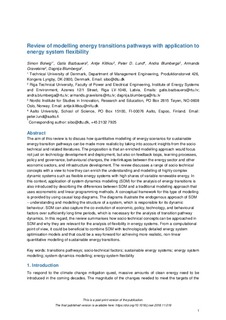Review of modelling energy transitions pathways with application to energy system flexibility
Bolwig, Simon; Bazbauers, Gatis; Klitkou, Antje; Lund, Peter D.; Blumberga, Andra; Gravelsinš, Armands; Blumberga, Dagnija
Journal article, Peer reviewed
Accepted version

Åpne
Permanent lenke
http://hdl.handle.net/11250/2578281Utgivelsesdato
2018Metadata
Vis full innførselSamlinger
Originalversjon
Renewable & Sustainable Energy Reviews. 2018, 101 (March), 440-452. 10.1016/j.rser.2018.11.019Sammendrag
The aim of this review is to discuss how quantitative modelling of energy scenarios for sustainable energy transition pathways can be made more realistic by taking into account insights from the socio-technical and related literatures. The proposition is that an enriched modelling approach would focus not just on technology development and deployment, but also on feedback loops, learning processes, policy and governance, behavioural changes, the interlinkages between the energy sector and other economic sectors, and infrastructure development. The review discusses a range of socio-technical concepts with a view to how they can enrich the understanding and modelling of highly complex dynamic systems such as flexible energy systems with high shares of variable renewable energy. In this context, application of system dynamics modelling (SDM) for the analysis of energy transitions is also introduced by describing the differences between SDM and a traditional modelling approach that uses econometric and linear programming methods. A conceptual framework for this type of modelling is provided by using causal loop diagrams. The diagrams illustrate the endogenous approach of SDM – understanding and modelling the structure of a system, which is responsible for its dynamic behaviour. SDM can also capture the co-evolution of economic, policy, technology, and behavioural factors over sufficiently long time periods, which is necessary for the analysis of transition pathway dynamics. In this regard, the review summarises how socio-technical concepts can be approached in SDM and why they are relevant for the analysis of flexibility in energy systems. From a computational point of view, it could be beneficial to combine SDM with technologically detailed energy system optimization models and that could be a way forward for achieving more realistic, non-linear quantitative modelling of sustainable energy transitions.
Tidsskrift
Renewable & Sustainable Energy ReviewsBeslektede innførsler
Viser innførsler beslektet ved tittel, forfatter og emneord.
-
Modelling energy production flexibility: system dynamics approach
Gravelsinš, Armands; Bazbauers, Gatis; Blumberga, Andra; Blumberga, Dagnija; Bolwig, Simon; Klitkou, Antje; Lund, Peter D. (Journal article; Peer reviewed, 2018-09-08)Article shows how system dynamics modelling (SDM) approach could be used in modelling the energy transition towards low carbon energy system. SDM can be used to combine the techno-economic and socio-technical analysis. The ... -
Indicators of energy innovation systems and their dynamics: A review of current practice and research in the field
Borup, Mads; Klitkou, Antje; Andersen, Maj Munch; Hain, Daniel S.; Christensen, Jesper Lindgaard; Rennings, Klaus (Research report, 2013)The purpose of this ‘radar report’ is to give an overview of the state of the art concerning indicators of energy innovation systems and their dynamics. As part of this, it is the aim to discuss current challenges and ... -
Technology Opportunities in Nordic Energy System Transitions (TOP-NEST): Final report
Klitkou, Antje; Bolwig, Simon; Coenen, Lars; Solér, Ola; Scordato, Lisa (NIFU-rapport;2015:32, Research report, 2015-10)This report summarizes the outcomes of the 4-year research project “Technology Opportunities in Nordic Energy System Transitions (TOP-NEST). The project was funded by Nordic Energy Research, under the Sustainable Energy ...